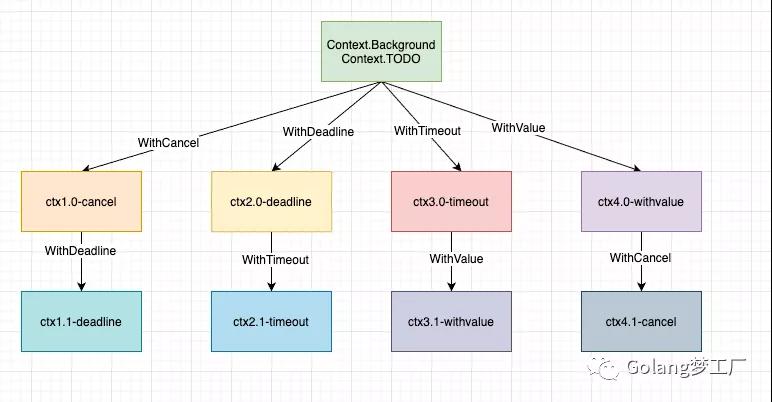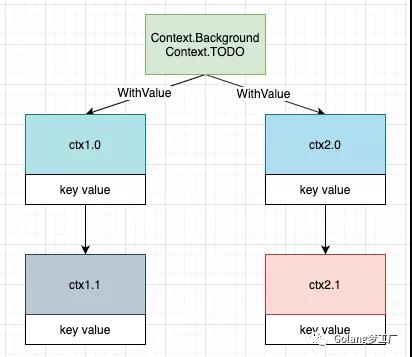前言
哈喽,大家好,我是asong。今天想与大家分享context包,经过一年的沉淀,重新出发,基于Go1.17.1从源码角度再次分析,不过这次不同的是,我打算先从入门开始,因为大多数初学的读者都想先知道怎么用,然后才会关心源码是如何实现的。
相信大家在日常工作开发中一定会看到这样的代码:
- func a1(ctx context ...){
- b1(ctx)
- }
- func b1(ctx context ...){
- c1(ctx)
- }
- func c1(ctx context ...)
context被当作第一个参数(官方建议),并且不断透传下去,基本一个项目代码中到处都是context,但是你们真的知道它有何作用吗以及它是如何起作用的吗?我记得我第一次接触context时,同事都说这个用来做并发控制的,可以设置超时时间,超时就会取消往下执行,快速返回,我就单纯的认为只要函数中带着context参数往下传递就可以做到超时取消,快速返回。相信大多数初学者也都是和我一个想法,其实这是一个错误的思想,其取消机制采用的也是通知机制,单纯的透传并不会起作用,比如你这样写代码:
- func main() {
- ctx,cancel := context.WithTimeout(context.Background(),10 * time.Second)
- defer cancel()
- go Monitor(ctx)
- time.Sleep(20 * time.Second)
- }
- func Monitor(ctx context.Context) {
- for {
- fmt.Print("monitor")
- }
- }
即使context透传下去了,没有监听取消信号也是不起任何作用的。所以了解context的使用还是很有必要的,本文就先从使用开始,逐步解析Go语言的context包,下面我们就开始喽!!!
context包的起源与作用
看官方博客我们可以知道context包是在go1.7版本中引入到标准库中的:
context可以用来在goroutine之间传递上下文信息,相同的context可以传递给运行在不同goroutine中的函数,上下文对于多个goroutine同时使用是安全的,context包定义了上下文类型,可以使用background、TODO创建一个上下文,在函数调用链之间传播context,也可以使用WithDeadline、WithTimeout、WithCancel 或 WithValue 创建的修改副本替换它,听起来有点绕,其实总结起就是一句话:context的作用就是在不同的goroutine之间同步请求特定的数据、取消信号以及处理请求的截止日期。
目前我们常用的一些库都是支持context的,例如gin、database/sql等库都是支持context的,这样更方便我们做并发控制了,只要在服务器入口创建一个context上下文,不断透传下去即可。
context的使用
创建context
context包主要提供了两种方式创建context:
- context.Backgroud()
- context.TODO()
这两个函数其实只是互为别名,没有差别,官方给的定义是:
- context.Background 是上下文的默认值,所有其他的上下文都应该从它衍生(Derived)出来。
- context.TODO 应该只在不确定应该使用哪种上下文时使用;
所以在大多数情况下,我们都使用context.Background作为起始的上下文向下传递。
上面的两种方式是创建根context,不具备任何功能,具体实践还是要依靠context包提供的With系列函数来进行派生:
- func WithCancel(parent Context) (ctx Context, cancel CancelFunc)
- func WithDeadline(parent Context, deadline time.Time) (Context, CancelFunc)
- func WithTimeout(parent Context, timeout time.Duration) (Context, CancelFunc)
- func WithValue(parent Context, key, val interface{}) Context
这四个函数都要基于父Context衍生,通过这些函数,就创建了一颗Context树,树的每个节点都可以有任意多个子节点,节点层级可以有任意多个,画个图表示一下:
基于一个父Context可以随意衍生,其实这就是一个Context树,树的每个节点都可以有任意多个子节点,节点层级可以有任意多个,每个子节点都依赖于其父节点,例如上图,我们可以基于Context.Background衍生出四个子context:ctx1.0-cancel、ctx2.0-deadline、ctx3.0-timeout、ctx4.0-withvalue,这四个子context还可以作为父context继续向下衍生,即使其中ctx1.0-cancel 节点取消了,也不影响其他三个父节点分支。
创建context方法和context的衍生方法就这些,下面我们就一个一个来看一下他们如何被使用。
WithValue携带数据
我们日常在业务开发中都希望能有一个trace_id能串联所有的日志,这就需要我们打印日志时能够获取到这个trace_id,在python中我们可以用gevent.local来传递,在java中我们可以用ThreadLocal来传递,在Go语言中我们就可以使用Context来传递,通过使用WithValue来创建一个携带trace_id的context,然后不断透传下去,打印日志时输出即可,来看使用例子:
- const (
- KEY = "trace_id"
- )
- func NewRequestID() string {
- return strings.Replace(uuid.New().String(), "-", "", -1)
- }
- func NewContextWithTraceID() context.Context {
- ctx := context.WithValue(context.Background(), KEY,NewRequestID())
- return ctx
- }
- func PrintLog(ctx context.Context, message string) {
- fmt.Printf("%s|info|trace_id=%s|%s",time.Now().Format("2006-01-02 15:04:05") , GetContextValue(ctx, KEY), message)
- }
- func GetContextValue(ctx context.Context,k string) string{
- v, ok := ctx.Value(k).(string)
- if !ok{
- return ""
- }
- return v
- }
- func ProcessEnter(ctx context.Context) {
- PrintLog(ctx, "Golang梦工厂")
- }
- func main() {
- ProcessEnter(NewContextWithTraceID())
- }
输出结果:
- 2021-10-31 15:13:25|info|trace_id=7572e295351e478e91b1ba0fc37886c0|Golang梦工厂
- Process finished with the exit code 0
我们基于context.Background创建一个携带trace_id的ctx,然后通过context树一起传递,从中派生的任何context都会获取此值,我们最后打印日志的时候就可以从ctx中取值输出到日志中。目前一些RPC框架都是支持了Context,所以trace_id的向下传递就更方便了。
在使用withVaule时要注意四个事项:
- 不建议使用context值传递关键参数,关键参数应该显示的声明出来,不应该隐式处理,context中最好是携带签名、trace_id这类值。
- 因为携带value也是key、value的形式,为了避免context因多个包同时使用context而带来冲突,key建议采用内置类型。
- 上面的例子我们获取trace_id是直接从当前ctx获取的,实际我们也可以获取父context中的value,在获取键值对是,我们先从当前context中查找,没有找到会在从父context中查找该键对应的值直到在某个父context中返回 nil 或者查找到对应的值。
- context传递的数据中key、value都是interface类型,这种类型编译期无法确定类型,所以不是很安全,所以在类型断言时别忘了保证程序的健壮性。
超时控制
通常健壮的程序都是要设置超时时间的,避免因为服务端长时间响应消耗资源,所以一些web框架或rpc框架都会采用withTimeout或者withDeadline来做超时控制,当一次请求到达我们设置的超时时间,就会及时取消,不在往下执行。withTimeout和withDeadline作用是一样的,就是传递的时间参数不同而已,他们都会通过传入的时间来自动取消Context,这里要注意的是他们都会返回一个cancelFunc方法,通过调用这个方法可以达到提前进行取消,不过在使用的过程还是建议在自动取消后也调用cancelFunc去停止定时减少不必要的资源浪费。
withTimeout、WithDeadline不同在于WithTimeout将持续时间作为参数输入而不是时间对象,这两个方法使用哪个都是一样的,看业务场景和个人习惯了,因为本质withTimout内部也是调用的WithDeadline。
现在我们就举个例子来试用一下超时控制,现在我们就模拟一个请求写两个例子:
- 达到超时时间终止接下来的执行
- func main() {
- HttpHandler()
- }
- func NewContextWithTimeout() (context.Context,context.CancelFunc) {
- return context.WithTimeout(context.Background(), 3 * time.Second)
- }
- func HttpHandler() {
- ctx, cancel := NewContextWithTimeout()
- defer cancel()
- deal(ctx)
- }
- func deal(ctx context.Context) {
- for i:=0; i< 10; i++ {
- time.Sleep(1*time.Second)
- select {
- case <- ctx.Done():
- fmt.Println(ctx.Err())
- return
- default:
- fmt.Printf("deal time is %d\n", i)
- }
- }
- }
输出结果:
- deal time is 0
- deal time is 1
- context deadline exceeded
- 没有达到超时时间终止接下来的执行
- func main() {
- HttpHandler1()
- }
- func NewContextWithTimeout1() (context.Context,context.CancelFunc) {
- return context.WithTimeout(context.Background(), 3 * time.Second)
- }
- func HttpHandler1() {
- ctx, cancel := NewContextWithTimeout1()
- defer cancel()
- deal1(ctx, cancel)
- }
- func deal1(ctx context.Context, cancel context.CancelFunc) {
- for i:=0; i< 10; i++ {
- time.Sleep(1*time.Second)
- select {
- case <- ctx.Done():
- fmt.Println(ctx.Err())
- return
- default:
- fmt.Printf("deal time is %d\n", i)
- cancel()
- }
- }
- }
输出结果:
- deal time is 0
- context canceled
使用起来还是比较容易的,既可以超时自动取消,又可以手动控制取消。这里大家要记的一个坑,就是我们往从请求入口透传的调用链路中的context是携带超时时间的,如果我们想在其中单独开一个goroutine去处理其他的事情并且不会随着请求结束后而被取消的话,那么传递的context要基于context.Background或者context.TODO重新衍生一个传递,否决就会和预期不符合了,可以看一下我之前的一篇踩坑文章:context使用不当引发的一个bug。
withCancel取消控制
日常业务开发中我们往往为了完成一个复杂的需求会开多个gouroutine去做一些事情,这就导致我们会在一次请求中开了多个goroutine确无法控制他们,这时我们就可以使用withCancel来衍生一个context传递到不同的goroutine中,当我想让这些goroutine停止运行,就可以调用cancel来进行取消。
来看一个例子:
- func main() {
- ctx,cancel := context.WithCancel(context.Background())
- go Speak(ctx)
- time.Sleep(10*time.Second)
- cancel()
- time.Sleep(1*time.Second)
- }
- func Speak(ctx context.Context) {
- for range time.Tick(time.Second){
- select {
- case <- ctx.Done():
- fmt.Println("我要闭嘴了")
- return
- default:
- fmt.Println("balabalabalabala")
- }
- }
- }
运行结果:
- balabalabalabala
- ....省略
- balabalabalabala
- 我要闭嘴了
我们使用withCancel创建一个基于Background的ctx,然后启动一个讲话程序,每隔1s说一话,main函数在10s后执行cancel,那么speak检测到取消信号就会退出。
自定义Context
因为Context本质是一个接口,所以我们可以通过实现Context达到自定义Context的目的,一般在实现Web框架或RPC框架往往采用这种形式,比如gin框架的Context就是自己有封装了一层,具体代码和实现就贴在这里,有兴趣可以看一下gin.Context是如何实现的。
源码赏析
Context其实就是一个接口,定义了四个方法:
- type Context interface {
- Deadline() (deadline time.Time, ok bool)
- Done() <-chan struct{}
- Err() error
- Value(key interface{}) interface{}
- }
- Deadlne方法:当Context自动取消或者到了取消时间被取消后返回
- Done方法:当Context被取消或者到了deadline返回一个被关闭的channel
- Err方法:当Context被取消或者关闭后,返回context取消的原因
- Value方法:获取设置的key对应的值
这个接口主要被三个类继承实现,分别是emptyCtx、ValueCtx、cancelCtx,采用匿名接口的写法,这样可以对任意实现了该接口的类型进行重写。
下面我们就从创建到使用来层层分析。
创建根Context
其在我们调用context.Background、context.TODO时创建的对象就是empty:
- var (
- background = new(emptyCtx)
- todo = new(emptyCtx)
- )
- func Background() Context {
- return background
- }
- func TODO() Context {
- return todo
- }
Background和TODO还是一模一样的,官方说:background它通常由主函数、初始化和测试使用,并作为传入请求的顶级上下文;TODO是当不清楚要使用哪个 Context 或尚不可用时,代码应使用 context.TODO,后续在在进行替换掉,归根结底就是语义不同而已。
emptyCtx类
emptyCtx主要是给我们创建根Context时使用的,其实现方法也是一个空结构,实际源代码长这样:
- type emptyCtx int
- func (*emptyCtx) Deadline() (deadline time.Time, ok bool) {
- return
- }
- func (*emptyCtx) Done() <-chan struct{} {
- return nil
- }
- func (*emptyCtx) Err() error {
- return nil
- }
- func (*emptyCtx) Value(key interface{}) interface{} {
- return nil
- }
- func (e *emptyCtx) String() string {
- switch e {
- case background:
- return "context.Background"
- case todo:
- return "context.TODO"
- }
- return "unknown empty Context"
- }
WithValue的实现
withValue内部主要就是调用valueCtx类:
- func WithValue(parent Context, key, val interface{}) Context {
- if parent == nil {
- panic("cannot create context from nil parent")
- }
- if key == nil {
- panic("nil key")
- }
- if !reflectlite.TypeOf(key).Comparable() {
- panic("key is not comparable")
- }
- return &valueCtx{parent, key, val}
- }
valueCtx类
valueCtx目的就是为Context携带键值对,因为它采用匿名接口的继承实现方式,他会继承父Context,也就相当于嵌入Context当中了
- type valueCtx struct {
- Context
- key, val interface{}
- }
实现了String方法输出Context和携带的键值对信息:
- func (c *valueCtx) String() string {
- return contextName(c.Context) + ".WithValue(type " +
- reflectlite.TypeOf(c.key).String() +
- ", val " + stringify(c.val) + ")"
- }
实现Value方法来存储键值对:
- func (c *valueCtx) Value(key interface{}) interface{} {
- if c.key == key {
- return c.val
- }
- return c.Context.Value(key)
- }
看图来理解一下:
所以我们在调用Context中的Value方法时会层层向上调用直到最终的根节点,中间要是找到了key就会返回,否会就会找到最终的emptyCtx返回nil。
WithCancel的实现
我们来看一下WithCancel的入口函数源代码:
- func WithCancel(parent Context) (ctx Context, cancel CancelFunc) {
- if parent == nil {
- panic("cannot create context from nil parent")
- }
- c := newCancelCtx(parent)
- propagateCancel(parent, &c)
- return &c, func() { c.cancel(true, Canceled) }
- }
这个函数执行步骤如下:
- 创建一个cancelCtx对象,作为子context
- 然后调用propagateCancel构建父子context之间的关联关系,这样当父context被取消时,子context也会被取消。
- 返回子context对象和子树取消函数
我们先分析一下cancelCtx这个类。
cancelCtx类
cancelCtx继承了Context,也实现了接口canceler:
- type cancelCtx struct {
- Context
- mu sync.Mutex // protects following fields
- done atomic.Value // of chan struct{}, created lazily, closed by first cancel call
- children map[canceler]struct{} // set to nil by the first cancel call
- err error // set to non-nil by the first cancel call
- }
字短解释:
- mu:就是一个互斥锁,保证并发安全的,所以context是并发安全的
- done:用来做context的取消通知信号,之前的版本使用的是chan struct{}类型,现在用atomic.Value做锁优化
- children:key是接口类型canceler,目的就是存储实现当前canceler接口的子节点,当根节点发生取消时,遍历子节点发送取消信号
- error:当context取消时存储取消信息
这里实现了Done方法,返回的是一个只读的channel,目的就是我们在外部可以通过这个阻塞的channel等待通知信号。
具体代码就不贴了。我们先返回去看propagateCancel是如何做构建父子Context之间的关联。
propagateCancel方法
代码有点长,解释有点麻烦,我把注释添加到代码中看起来比较直观:
- func propagateCancel(parent Context, child canceler) {
- // 如果返回nil,说明当前父`context`从来不会被取消,是一个空节点,直接返回即可。
- done := parent.Done()
- if done == nil {
- return // parent is never canceled
- }
- // 提前判断一个父context是否被取消,如果取消了也不需要构建关联了,
- // 把当前子节点取消掉并返回
- select {
- case <-done:
- // parent is already canceled
- child.cancel(false, parent.Err())
- return
- default:
- }
- // 这里目的就是找到可以“挂”、“取消”的context
- if p, ok := parentCancelCtx(parent); ok {
- p.mu.Lock()
- // 找到了可以“挂”、“取消”的context,但是已经被取消了,那么这个子节点也不需要
- // 继续挂靠了,取消即可
- if p.err != nil {
- child.cancel(false, p.err)
- } else {
- // 将当前节点挂到父节点的childrn map中,外面调用cancel时可以层层取消
- if p.children == nil {
- // 这里因为childer节点也会变成父节点,所以需要初始化map结构
- p.children = make(map[canceler]struct{})
- }
- p.children[child] = struct{}{}
- }
- p.mu.Unlock()
- } else {
- // 没有找到可“挂”,“取消”的父节点挂载,那么就开一个goroutine
- atomic.AddInt32(&goroutines, +1)
- go func() {
- select {
- case <-parent.Done():
- child.cancel(false, parent.Err())
- case <-child.Done():
- }
- }()
- }
- }
这段代码真正产生疑惑的是这个if、else分支。不看代码了,直接说为什么吧。因为我们可以自己定制context,把context塞进一个结构时,就会导致找不到可取消的父节点,只能重新起一个协程做监听。
对这块有迷惑的推荐阅读饶大大文章:[深度解密Go语言之context](https://www.cnblogs.com/qcrao-2018/p/11007503.html),定能为你排忧解惑。
cancel方法
最后我们再来看一下返回的cancel方法是如何实现,这个方法会关闭上下文中的 Channel 并向所有的子上下文同步取消信号:
- func (c *cancelCtx) cancel(removeFromParent bool, err error) {
- // 取消时传入的error信息不能为nil, context定义了默认error:var Canceled = errors.New("context canceled")
- if err == nil {
- panic("context: internal error: missing cancel error")
- }
- // 已经有错误信息了,说明当前节点已经被取消过了
- c.mu.Lock()
- if c.err != nil {
- c.mu.Unlock()
- return // already canceled
- }
- c.err = err
- // 用来关闭channel,通知其他协程
- d, _ := c.done.Load().(chan struct{})
- if d == nil {
- c.done.Store(closedchan)
- } else {
- close(d)
- }
- // 当前节点向下取消,遍历它的所有子节点,然后取消
- for child := range c.children {
- // NOTE: acquiring the child's lock while holding parent's lock.
- child.cancel(false, err)
- }
- // 节点置空
- c.children = nil
- c.mu.Unlock()
- // 把当前节点从父节点中移除,只有在外部父节点调用时才会传true
- // 其他都是传false,内部调用都会因为c.children = nil被剔除出去
- if removeFromParent {
- removeChild(c.Context, c)
- }
- }
到这里整个WithCancel方法源码就分析好了,通过源码我们可以知道cancel方法可以被重复调用,是幂等的。
withDeadline、WithTimeout的实现
先看WithTimeout方法,它内部就是调用的WithDeadline方法:
- func WithTimeout(parent Context, timeout time.Duration) (Context, CancelFunc) {
- return WithDeadline(parent, time.Now().Add(timeout))
- }
所以我们重点来看withDeadline是如何实现的:
- func WithDeadline(parent Context, d time.Time) (Context, CancelFunc) {
- // 不能为空`context`创建衍生context
- if parent == nil {
- panic("cannot create context from nil parent")
- }
- // 当父context的结束时间早于要设置的时间,则不需要再去单独处理子节点的定时器了
- if cur, ok := parent.Deadline(); ok && cur.Before(d) {
- // The current deadline is already sooner than the new one.
- return WithCancel(parent)
- }
- // 创建一个timerCtx对象
- c := &timerCtx{
- cancelCtx: newCancelCtx(parent),
- deadline: d,
- }
- // 将当前节点挂到父节点上
- propagateCancel(parent, c)
- // 获取过期时间
- dur := time.Until(d)
- // 当前时间已经过期了则直接取消
- if dur <= 0 {
- c.cancel(true, DeadlineExceeded) // deadline has already passed
- return c, func() { c.cancel(false, Canceled) }
- }
- c.mu.Lock()
- defer c.mu.Unlock()
- // 如果没被取消,则直接添加一个定时器,定时去取消
- if c.err == nil {
- c.timer = time.AfterFunc(dur, func() {
- c.cancel(true, DeadlineExceeded)
- })
- }
- return c, func() { c.cancel(true, Canceled) }
- }
withDeadline相较于withCancel方法也就多了一个定时器去定时调用cancel方法,这个cancel方法在timerCtx类中进行了重写,我们先来看一下timerCtx类,他是基于cancelCtx的,多了两个字段:
- type timerCtx struct {
- cancelCtx
- timer *time.Timer // Under cancelCtx.mu.
- deadline time.Time
- }
timerCtx实现的cancel方法,内部也是调用了cancelCtx的cancel方法取消:
- func (c *timerCtx) cancel(removeFromParent bool, err error) {
- // 调用cancelCtx的cancel方法取消掉子节点context
- c.cancelCtx.cancel(false, err)
- // 从父context移除放到了这里来做
- if removeFromParent {
- // Remove this timerCtx from its parent cancelCtx's children.
- removeChild(c.cancelCtx.Context, c)
- }
- // 停掉定时器,释放资源
- c.mu.Lock()
- if c.timer != nil {
- c.timer.Stop()
- c.timer = nil
- }
- c.mu.Unlock()
- }
终于源码部分我们就看完了,现在你何感想?
context的优缺点
context包被设计出来就是做并发控制的,这个包有利有弊,个人总结了几个优缺点,欢迎评论区补充。
缺点
- 影响代码美观,现在基本所有web框架、RPC框架都是实现了context,这就导致我们的代码中每一个函数的一个参数都是context,即使不用也要带着这个参数透传下去,个人觉得有点丑陋。
- context可以携带值,但是没有任何限制,类型和大小都没有限制,也就是没有任何约束,这样很容易导致滥用,程序的健壮很难保证;还有一个问题就是通过context携带值不如显式传值舒服,可读性变差了。
- 可以自定义context,这样风险不可控,更加会导致滥用。
- context取消和自动取消的错误返回不够友好,无法自定义错误,出现难以排查的问题时不好排查。
- 创建衍生节点实际是创建一个个链表节点,其时间复杂度为O(n),节点多了会掉支效率变低。
优点
使用context可以更好的做并发控制,能更好的管理goroutine滥用。
context的携带者功能没有任何限制,这样我我们传递任何的数据,可以说这是一把双刃剑
网上都说context包解决了goroutine的cancelation问题,你觉得呢?
参考文章
https://pkg.go.dev/context@go1.7beta1#Background https://studygolang.com/articles/21531 https://draveness.me/golang/docs/part3-runtime/ch06-concurrency/golang-context/ https://www.cnblogs.com/qcrao-2018/p/11007503.html https://segmentfault.com/a/1190000039294140 https://www.flysnow.org/2017/05/12/go-in-action-go-context.html
总结
context虽然在使用上丑陋了一点,但是他却能解决很多问题,日常业务开发中离不开context的使用,不过也别使用错了context,其取消也采用的channel通知,所以代码中还有要有监听代码来监听取消信号,这点也是经常被广大初学者容易忽视的一个点。
文中示例已上传github:https://github.com/asong2020/Golang_Dream/tree/master/code_demo/context_example
好啦,本文到这里就结束了,我是asong,我们下期见。







































